
Find out which vegetables are “friends” and grow best in the same bed. Plus, there are a handful of veggies that shouldn’t share a bed. Our Vegetable Companion Planting Chart also includes herbs and flowers!
What Is Companion Planting?
Companion planting is the practice of growing one plant to help another as part of a community. Fruits, vegetables, and herbs are noticeably more resilient and productive when each member supports the next. The benefits can be one-way, such as when nectar-rich flowers planted around fruiting crops, like tomatoes, improve insect pollination, or reciprocal, such as when the famous Three Sisters of corn, pole beans, and squash are grown together for mutual benefit.
By growing communities of plants that are known to support each other, you can save a lot of time and potential heartache. This is nature’s way of minimizing pest damage, boosting soil fertility, reducing weed competition, and, ultimately, increasing yields. Productive gardens cultivated with companion planting in mind also tend to look better, too!
Knowing which plants grow well together is helpful. This is a tried-and-tested way to reduce pests, attract pollinators, and boost growth! Here are common examples.
- Tomatoes and basil are natural companions in the kitchen and garden. Basil repels certain insect pests, such as thrips, and also disorients moths that lay tomato hornworms.
- Aphids severely crimp your crop! But aphids can’t stand garlic! With this in mind, garlic planted as a barrier makes crops less vulnerable to pest attack. For example, grow potatoes between rows of garlic—it serves as a pungent bodyguard.
- Nasturtium flowers grown close to kale, cabbage, broccoli, and any brassica plants will lure hungry caterpillars away from eating your crops.
See more examples and a full chart of proven companions below!
7 Benefits of Companion Planting
There are plenty more good reasons to plant certain crops together:
- Deterring pests: One of the biggest challenges for any gardener is pests. Sure, you can spray pesticides, but these are very blunt tools that have serious repercussions for nontarget species, including beneficial bugs. It’s better to plant companions. Planting single crops in large blocks—which many of us do—makes it easier for pests to find and attack them. However, overwhelming evidence supports the homesteader’s hunch that intermingling crops makes for fewer nemeses.
- Attracting beneficials: Some plants also attract beneficial insects. For example, borage attracts pollinating bees and tiny pest-eating wasps. Beneficial insect-attracting plants have received the thumbs-up from researchers, validating the efforts of gardeners who plant “pollinator strips” (rows of pollinator-magnet plants) within the garden to encourage pollinators and pest predators.
- Shade regulation: Large plants provide shade for smaller plants needing sun protection—for example, corn shades lettuce.
- Natural supports: Tall plants, like corn and sunflowers, can support lower-growing, sprawling crops such as cucumbers and peas.
- Improved plant health: When one plant absorbs certain substances from the soil, it may change the soil biochemistry in favor of nearby plants.
- Improving soil fertility: Some crops, like beans, peas, and other legumes, help to make nitrogen more available in the soil. Similarly, plants with long taproots, like burdock, bring up nutrients from deep in the soil, enriching the topsoil to the benefit of shallow-rooted plants.
- Weed suppression: Planting sprawling crops like potatoes with tall, upright plants minimizes open areas where weeds typically take hold.
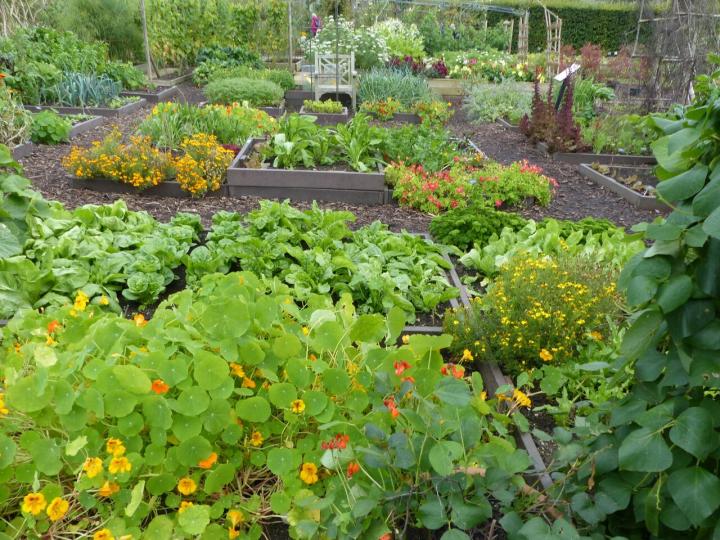
Evidence-Based Companion Planting Philosophy
Until recently, a lot of companion planting was based on little more than hearsay, but there’s an increasing body of scientifically grounded research that proves that growing specific plants together can reduce pests, boost growth, and even help wildlife. We’ve collected it all and updated our companion planting chart below! Some background:
- Traditionally, it was thought that vegetables had “friends” and “foes”—companion plants that either benefitted the vegetables’ growth or impeded it. This isn’t necessarily wrong, but we’ve found that nearly all the associations are positive; there are perhaps two or three “bad” combinations (e.g., black walnut trees, which secrete growth inhibitors through their roots). The bottom line is that there is simply more evidence for “good” companions than “bad” ones, so we now focus more on why vegetables need friends!
- There are misconceptions about companion planting on the internet, which we found concerning. Many examples of companion planting were based on folklore or hearsay. While observations in our own garden can be valuable, we decided that our reference guide should only highlight companion plant pairings backed up by scientific evidence and tried-and-true practices.
- While companion planting traditionally referred to vegetable plant pairs, we’ve added more flowers to our chart; many are excellent natural insect repellents. Nasturtium is head and shoulders above them all, taking the brunt of pest attacks. (See more below.) Of course, any nectar-rich flowers such as zinnia, comfrey, and ageratum will attract pollinators such as bees to the garden and help to boost the pollination of flowering crop plants like tomatoes, beans, and squash.
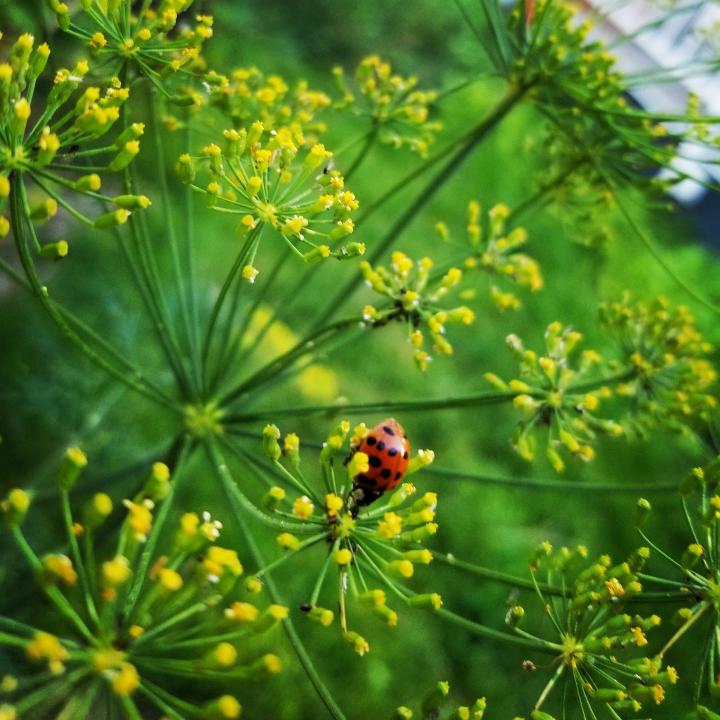
Examples of the Best Companion Plants
Here are some of the best companion planting combinations for your garden. (See more in the chart below.)
- Basil is a help to tomatoes as an interplanted repellent to thrips, as mentioned above. Basil also deters moths that lay eggs for tomato hornworms and armyworms. Basil also attracts bees, which improves pollination, tomato health, and flavor.
- Dill attracts ladybugs, which eat tiny garden pests such as aphids and spider mites.
- Borage pairs well with tomatoes, attracting pollinating bees. It also enhances strawberries’ flavor and vigor.
- Garlic and garlic spray have a strong scent that deters many insects. Aphids can’t stand garlic! Garlic also repels onion flies, ermine moths, and Japanese beetles. Plant garlic between rows of potatoes alongside lettuces and cabbages and near fruit trees, together with alyssum, to attract aphid-eating hoverflies.
- Mint deters aphids, ants, and flea beetles. Just be careful to plant mint nearby in its own pot or bed, as it is a very aggressive grower!
- Nasturtiums attract hungry caterpillars away from brassicas like cabbage, broccoli, and kale, so grow these pretty flowers close to those crops; nasturtiums also lure black flies away from fava beans.
- Parsley attracts beneficial insects to protect and pollinate tomatoes. Plant these herbs between tomatoes.
- Poached egg plants (a wildflower) draw in hoverflies, which control aphids on nearby lettuce.
- Sage is a helpful herb that repels carrot flies. Also, plant it around a cabbage patch to reduce injury from cabbage moths.
- Sunflowers pair well with cucumbers and pole beans. They help provide support for climbing plants and shade for crops, which can become sun-stressed in hotter climates.
- Tansy is a real draw to pest-eating bugs such as ladybugs, ladybirds, and predatory wasps. At the same time, tansy repels many typical baddies, such as cutworm, which attacks asparagus, bean, cabbage, carrot, celery, corn, lettuce, pea, pepper, potato, and tomato plants. Tansy is a perennial, which means you only have to plant it once. What more could you want in a garden flower?
Add more flowers! Growing calendula or cosmos nearby will attract tiny parasitizing wasps and aphid-hungry hoverflies. We also love marigolds for drawing in pest-hungry beneficial bugs.
The Science Behind Companion Planting
Many studies have put specific plant-insect relationships under the spotlight. For example, researchers at the University of Nebraska found that radishes planted with pumpkins appear to repel squash bugs. Similarly, it has been shown elsewhere that nasturtiums grown around fruit trees can deter pests such as codling moths because nasturtiums secrete water-soluble glucosinolates from their roots into the soil. These can then be taken up by the trees, which take on the same defensive superpowers.
Many brassica family plants, including mustards, horseradish, cabbage, and kale, also use glucosinolates to defend against pests.
Some companion combinations work because one plant hides the presence of another, such as that inseparable duo of tomato and basil.
Analysis by the University of Nice Sophia Antipolis in France saw a reduction in tomato pests when basil was present—great news for gardeners looking to outwit thrips, a common carrier of the tomato spotted wilt virus. Plus, while pest populations decreased, no increase in pest predators was detected as the cause, indicating that basil’s strong scent disguised the tomatoes from pests. Leaf shape can also do a great job of obscuring a target plant.
Faced with a confusing array of leaves, a pest may fail to recognize its host plant amidst the melee. This works with thyme, another tomato companion. Scientists at Iowa State saw a reduction in egg-laying by adult armyworms when tomatoes were interplanted with the herb. Used as a living mulch like this, thyme presented small leaves that did a great job of confusing the moths.
Many flowers rich in nectar and irresistible to bees, butterflies, and other pollinators are also a big draw for insects that make a meal of garden pests. Hoverflies can’t resist the sunny-side-up charms of poached egg plants (Limnanthes douglasii), and they love a meal of juicy aphids, too. Pop poached egg plants near lettuces, and guess what? Fewer aphids!
Another example is borage, which attracts tiny wasps that are the natural enemies of tomato hornworm caterpillars. Borage is also a well-known bee magnet, so with it, you get a twofer: boosted pollination plus wasps laying parasitic eggs to purge notorious hornworm pests. The very best friend that any tomato could wish for!
A study published by the Kentucky Academy of Science in Louisville found that planting dwarf sunflowers around a field of corn attracted an army of pest-hungry ladybugs. Other research confirms the effectiveness of dill in attracting parasitic wasps to control cabbage worms and cabbage loopers; researchers at Rutgers University in New Jersey have also shown that dill also does a great job of luring enemies of the Colorado potato beetle.
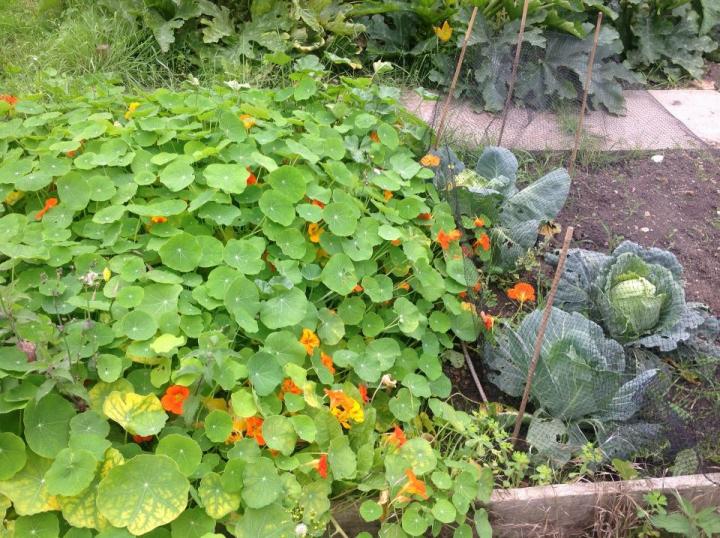
Credit: Catherine Boeckmann
Companion Planting Chart: 20 Common Vegetables
In this chart, you’ll find some of the most common garden crops and their suitable companion plants. For more plants, we’d point you to the online Almanac Garden Planner, which has an extensive database of companion plants and a new companion planting feature that makes it easier than ever to find perfect matches for your plants. (Simply select a crop, then click on the heart-shaped Companion Planting button. The selection bar will then show only those plants your chosen crop will love. Select one and drop it into your garden plan.)
Companion Planting Chart
| Crop Name | Companions | Benefits and Notes |
|---|---|---|
ASPARAGUS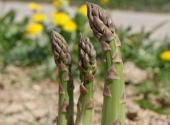 |
Calendula Petunias Tomatoes |
Calendula, tomatoes, and petunias are thought to deter asparagus beetles. |
BASIL |
Peppers Purslane Tomatoes |
Purslane is used to shade the soil around basil plants, helping them to remain fresh in hot weather. Basil improves the growth and flavor of tomatoes and peppers. |
BEANS  |
Beets Corn Lovage Nasturtium Rosemary Squash Strawberries Sunflower |
Nasturtiums can be used as a trap plant to entice aphids away from beans. Lovage and rosemary also have excellent insect-repellent qualities. Sunflowers can be used to create shade for sun-stressed crops. Corn will benefit from the beans’ nitrogen-fixing capabilities. Pole beans provide structural support. |
BEETS |
Brassicas Bush beans Garlic Lettuce Onion family |
Beets are companions for chicory and endive. Onions protect against borers and cutworms. Beets add minerals to the soil, as beet leaves are composed of 25% magnesium. |
BROCCOLI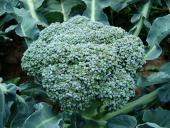 |
Oregano Other Brassicas (Cabbage, brussels sprouts, cauliflower, etc.) |
Oregano has insecticidal properties. Plant Brassicas together so that they can all be covered with nets to protect from pests such as cabbage worms. They also all like lime added to the soil. |
CABBAGE |
Garlic Nasturtium Sage |
Nasturtiums deter insect pests such as beetles and aphids. Garlic repels insects with its odor when planted alongside cabbage. Sage deters cabbage moths. |
CARROTS |
Chives Leeks Onions Peas Radishes Rosemary Sage |
Chives improve the growth and flavor of carrots and deter aphids, mites, and flies. Rosemary and sage repel the carrot fly. Leeks are thought to repel many flying pests (including carrot rust fly). Foes: Dill can reduce the yield of carrots. |
CORN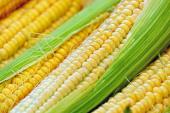 |
Beans (pole) Cucumbers Dill Melons Peas Squash Sunflower |
Dill is thought to protect against aphids and mites. Beans can provide more nitrogen to the corn. Sunflowers can act as a structure and a windbreak for corn, and dwarf sunflowers bring in ladybugs to control aphids. Pole beans are sometimes interplanted with corn, adding nitrogen and providing structural support. Spinach grows well in the shade of corn, keeping corn roots cool. |
CUCUMBERS |
Beans Borage Dill Lettuce Nasturtiums Oregano Radish Sunflowers Tansy |
Dill is thought to protect against aphids and mites. Nasturtium deters aphids, beetles, and bugs and improves growth and flavor. Oregano deters pests in general. Radish, Nasturtium, and Tansy repel cucumber beetles; radish also repels flea beetles. Tansy also deters ants, beetles, bugs, and flying insects, as does borage, improving flavor and growth. |
LETTUCE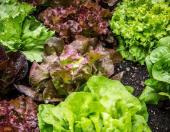 |
Chives Onions Oregano Peas Poached Egg plants Radishes Scallions Zinnia |
Chives, onions, and garlic deter aphids and other pests by masking the scent of the lettuce with their aroma. Basil is thought to improve the flavor and growth of lettuce. Radishes can be used as a trap crop for flea beetles. Poached egg plants (Limnanthes), a wildflower, will bring hoverflies and other beneficials that eat aphids. |
ONIONS |
Beets Cabbage Carrot Chard Lettuce Strawberry Tomatoes |
Onions protect against borers and cutworms. Their aroma disorients pests. Onions benefit from marigolds as the smell of marigolds reduces the egg laying of onion maggot fly. |
PEAS |
Alyssum Carrot Chives Corn Grapes Lettuce Mint Radish Spinach Turnip |
Chives deter aphids. Mint improves health and flavor. Alyssum brings in pollinators and encourages green lacewings, which eat aphids. Foes: Do not plant near garlic and onion, as they will stunt the growth of peas. |
PEPPERS |
Basil Marjoram Onions Oregano |
Herbs like basil, oregano, and marjoram have a protective, insecticidal quality. |
POTATOES |
Basil Beans Calendula Catmint Cilantro Garlic Horseradish Oregano Peas Tansy |
Beans can improve the size of potato tubers. Cilantro protects against aphids, spider mites, and potato beetles. Calendula, tansy, and horseradish planted at the corner of a potato patch ward off Colorado potato beetles. (Note: Tansy is considered invasive in some areas. See local guidelines before planting.) Catmint also repels Colorado potato beetles but can bring cats into the vegetable garden, so it is a good idea to plant it in pots around the edge of the plot. |
RADISHES |
Chervil Lettuce Nasturtium Peas |
Chervil improves growth and flavor. Nasturtiums are a good trap crop for radishes. Radishes are often used as trap crops for flea beetles. Peas give nitrogen to the soil, which benefits radishes. |
| WINTER SQUASH and PUMPKINS 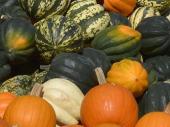 |
Beans (pole) Buckwheat Calendula Corn Marigold Nasturtium Oregano |
Buckwheat brings in pest predators, which reduce insect pests. Nasturtiums protect against pumpkin and squash beetles. Oregano provides general pest protection. Calendula deters beetles and root nematodes. Squash is traditionally planted with corn and beans (“three sisters”) to disorient the adult vine borer. |
SPINACH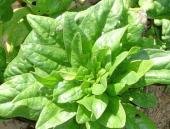 |
Beans Cilantro Eggplant Oregano Peas Rosemary Strawberries |
Peas and beans provide natural shade for spinach. Cilantro, oregano, and rosemary are thought to repel insects. |
TOMATOES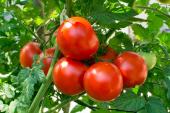 |
Asparagus Basil Borage Calendula Dill Garlic Nasturtium Onion Parsley Thyme |
Calendula deters general garden pests. Asparagus repels nematodes. Basil repels whiteflies, mosquitoes, spider mites, and aphids. Basil also attracts bees, which improves pollination, tomato health, and flavor. Borage repels hornworms. Dill makes it difficult for cutworms to lay their eggs and supports parasitic wasps that attack pest caterpillars. Thyme reduces egg laying by armyworms. |
ZUCCHINI/ SUMMER SQUASH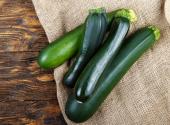 |
Buckwheat Oregano Nasturtium Zinnia |
Buckwheat brings in pest predators which reduce insect pests. To attract pollinators, plant oregano and zinnias. Nasturtium protects against aphids and whiteflies. |
Video: How to Plan a Companion Planting
It really helps to see companion planting in action. In this video, Ben focuses on how to harness the power of flowers to deter pests, attract pollinators, and even improve your soil.
More Companion Gardening Tips
Much of companion planting considers the height of different vegetables.
- Lettuce, radishes, and other quick-growing plants sown between hills of melons or winter squash will mature and be harvested long before these vines need more legroom.
- Leafy greens like spinach and Swiss chard will grow in the shadow of corn.
- Bush beans tolerate the dapple shade that corn casts and, since their roots occupy different levels in the soil, don’t compete for water and nutrients.
- Don’t get too fixated with pairing up crops. Correct spacing, sun, water, and good soil management are the most important influences on your growing plants.
- Why not start small with a few marigolds and zinnia seeds—and watch the beneficial bugs come! Other options to start with? How about calendula, nasturtium, basil, and borage?
A Useful Companion Planting Tool
All of this companion planning information is well and good, but honestly, who has the time to research scientifically rigorous companion planting combinations?
That’s why we have our Garden Planner. Our team has spent many months—years even—trawling through much of the peer-reviewed research in this area, exhaustively working out what is proven and what is not. The result is the Garden Planner’s Evidence-Based Companion Planting tool.
Simply select a garden vegetable on the screen and then click the ‘Show Companions’ button. The selection of plants is filtered to show only those plants that grow especially well with your chosen vegetable!!
For example, if you select sweet corn and click on the Companion Plantings button, it shows that beans are a great companion! Learn more about the Garden Planner.

Learn More
- For ideas and inspiration, see readers’ companion garden plot plans with plant lists.
- Are you just getting started with gardening, or do you need a refresher course? Check out our Vegetable Gardening for Beginners how-to page.
- Need plant-specific growing advice? Read through our many Growing Guides for vegetables, fruit, flowers, and herbs.
Companion planting can indeed help gardeners to grow in step with nature, but what we know about this powerful tool is constantly evolving. Further research over the coming years will fill in the gaps and no doubt deliver a few more surprises along the way
Have you tried companion planting? What’s your go-to pairing? Tell us in the comments below!


:max_bytes(150000):strip_icc()/tomato-garden-2000-d3de7267d65c442b987c67c6e43e5e1e.jpg?w=768&resize=768,0&ssl=1)
:strip_icc()/husky-cherry-tomato-19198666-89f5bcca9a39475a88b6ec3373cee434.jpg?w=768&resize=768,0&ssl=1)
